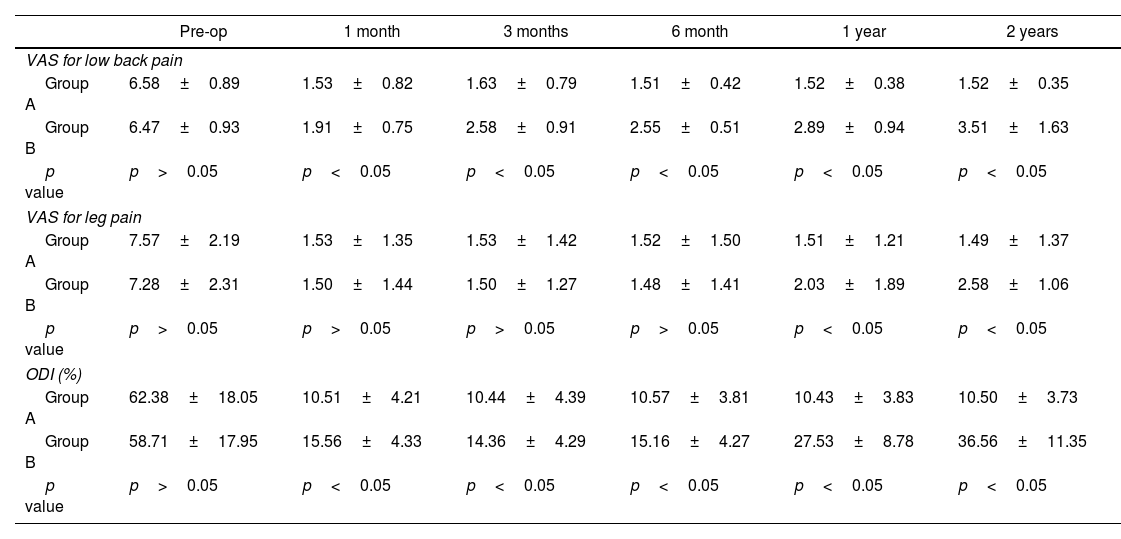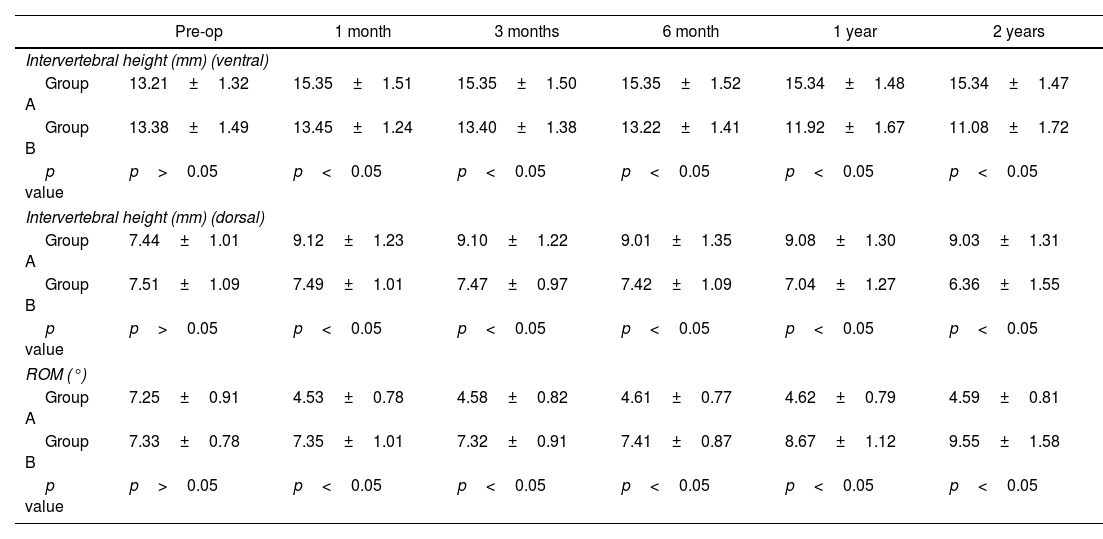The study aimed to explore the clinical outcomes of discectomy with dynamic neutralization system (Dynesys) for single-segmental lumbar disk herniation (LDH) versus simple discectomy.
MethodsThe eligible patients with single-segmental LDH were randomly divided into the discectomy with Dynesys group (group A) and the simple discectomy group (group B). The Oswestry disability index (ODI), visual analog score (VAS), radiological results of intervertebral height and range of motion (ROM) of the treated segment were evaluated pre- and post-operatively in both groups. Operation duration and blood loss were recorded. Complications, reoperation, and mortality were also assessed. All patients received a 2-year follow-up.
Results123 (96.1%) participants completed the follow-up. The operation duration and blood loss of group B were significantly lower than those of group A (p<0.05). After operation, ODI and VAS were improved significantly in both groups, and there was no significant difference between the two groups immediately after surgery. But a rising trend was found in ODI and VAS of group B, especially after the 1-year follow-up (p<0.05). X-rays showed a continuing loss of intervertebral height of the treated segment in group B, while it was preserved in group A (p<0.05). ROM of the treated segment was also maintained stable in group A.
ConclusionDiscectomy with Dynesys is safe and effective for LDH treatment.
El objetivo de este estudio es explorar los resultados clínicos de la discectomía con sistema de neutralización dinámica (Dynesys) para la hernia de disco lumbar (LDH) de un solo segmento vs. la discectomía simple.
MétodosLos pacientes elegibles con LDH de un solo segmento se dividieron aleatoriamente en el grupo de discectomía con Dynesys (grupo A) y el grupo de discectomía simple (grupo B). El índice de discapacidad de Oswestry (ODI), la puntuación analógica visual (VAS), los resultados radiológicos de la altura intervertebral y el rango de movimiento (ROM) del segmento tratado se evaluaron antes y después de la operación en ambos grupos. Se registraron la duración de la operación y la pérdida de sangre. También se evaluaron las complicaciones, la reintervención y la mortalidad. Todos los pacientes recibieron un seguimiento de dos años.
ResultadosCompletaron el seguimiento 123 (96,1%) participantes. La duración de la operación y la pérdida de sangre del grupo B fueron significativamente menores que las del grupo A (p < 0,05). Después de la operación, ODI y VAS mejoraron significativamente en ambos grupos y no hubo diferencias significativas entre los dos grupos inmediatamente después de la cirugía. Pero se encontró una tendencia ascendente en ODI y EVA del grupo B, especialmente después del seguimiento de un año (p < 0,05). Las radiografías mostraron una pérdida continua de la altura intervertebral del segmento tratado en el grupo B, mientras que se conservó en el grupo A (p < 0,05). El ROM del segmento tratado también se mantuvo estable en el grupo A.
ConclusiónLa discectomía con Dynesys es segura y efectiva para el tratamiento de LDH.
Article

If it is the first time you have accessed you can obtain your credentials by contacting Elsevier Spain in suscripciones@elsevier.com or by calling our Customer Service at902 88 87 40 if you are calling from Spain or at +34 932 418 800 (from 9 to 18h., GMT + 1) if you are calling outside of Spain.
If you already have your login data, please click here .
If you have forgotten your password you can you can recover it by clicking here and selecting the option ¿I have forgotten my password¿.











